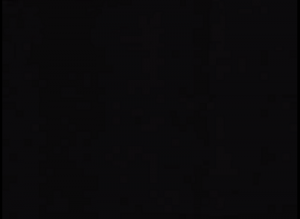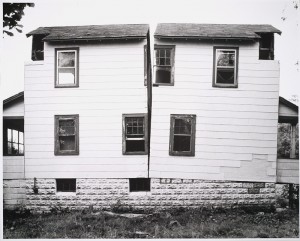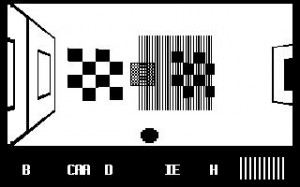The notion of interference – art as a mode interference – is associated with the conventional avant-garde self-image of critical subversion. The latter envisages that there is something like an unreflective signal – cast in terms of notions of power, consumption, ideology, etc. – that art finds the means to unsettle and pull apart. Art intervenes (at an awkward remove) and disrupts (without, however, quite touching). Three iconic works in this vein: Guy Debord’s film, Critique of Separation (1961); Gordon Matta-Clark’s public, sculptural intervention, Splitting (1974); and Jodi’s game modification, Sod (2000).
Three quarters of the way through Critique of Separation, Debord’s essay-style documentary on the problems of cinema, which mixes intense reflective narration, scenes of Paris, news reel material, comic book imagery and footage of Situationist work and activities, there is short sequence that reprises a technique from Debord’s earlier film, On the Passage of a Few Persons Through a Rather Brief Unity of Time (1959). The screen goes blank. The film imagery disappears. In the earlier film blankness is realised through a white screen, whereas here it is through a black screen. It is as though almost nothing of the cinematic image can be permitted to remain – not even projected light (with its sense, perhaps, of the imaginary conviviality of the film theatre). The black screen appears as a pointed gesture of negation. The voice-over, which normally has a wayward, detourned relation to the film imagery, suddenly speaks directly to the image.
It is necessary to destroy memory in art. To undermine the conventions of its communication. To demoralize its fans. What a task! As in a blurry drunken vision, the memory and language of the film fade out simultaneously. At the extreme, miserable subjectivity is reversed into a certain sort of objectivity: a documentation of the conditions of noncommunication.
This sequence provides an emblematic example of critical disruption – of destructive interference. The film image is subverted in order that the truth of the spectacular relation to the real that film entails should appear. Nonetheless, important to acknowledge that the film is not entirely ruined. There is still the black. I think of Chris Marker’s famous line from the beginning of his film, Sans Soleil (1983), in which short sequences of black leader are juxtaposed with images of military aircraft and children on a road in Iceland, “If they don’t see happiness, at least they’ll see the black”. This negative image – this image of the negation of images – raises the issue of the staging of interference, the representation of disruption in legible and coherent terms.
If Debord, at least in this early phase of Situationist practice, permits the critique of film to occur via means of film, if he does not altogether disrupt the underlying medium, Gordon Matta Clark literally destroys the house in order to manifest the sculptural work. He cuts the house in half. No doubt this gesture is ambiguous. At one level it can be regarded positively as a form of non-instrumental architecture – a means of opening up new spatial possibilities within the real. At another level it summons a more negative reading – serving as a critique of the closure of contemporary space (especially here domestic space). Matthew Fuller, in his Behind the Blip (2003), argues that Matta Clark’s various splitting works offer an inspiring model for contemporary software art practice. Drawing upon Matta-Clark, he argues that a major aim of software art should be less to produce functioning software than to interfere with the technical and cultural software system – to discover effective means of disrupting it.
Jodi’s Wolfenstein 3D game modification, SOD, appears as a characteristic realisation of this subversive goal. Stripping away the experience of illusory 3D space, it exposes dimensions of underlying computational artifice. The 3D engine is corrupted so that something of its mechanisms and abstraction can be revealed. Of course SOD’s black and white, curiously flattened space of planes, shapes and data is itself an imaginary construct. The underlying game, as field of invisible code-based operation, does not and cannot appear. Worth noting as well that the work still relies upon aspects of the original engine. The engine provides the functional basis for the work of artistic critique.
Overall, despite their strands of ambiguity, compromise and contradiction, these three works serve as examples of whatever it is that creative interference means. Risking oversimplification, we could summarise their various forms of interference in the following terms:
the image is fucked
the house is fucked
the world is fucked
At the same time, however, we would have to acknowledge that this interference is chiefly symbolic. It takes place within the sphere of art. Matta-Clark’s practice may have occasionally broken the law, but once framed within the context of art it clearly represents no integral criminal or political-revolutionary threat to the wider field of spatial relations or, more specifically, instrumental architecture. Certainly he intervenes within a particular space – cuts in half a particular home – but this dimension of interference can hardly be equated with the more general interference that would be needed to convincingly disrupt the broader field of socio-spatial relations. So, without any sense of criticism, without any suggestion of aesthetic failure, we can qualify our summary of the forms of interference in the following terms.
the image is fucked || films continue to be made and seen
the house is fucked || houses continue to be built and lived in
the world is fucked || virtual worlds continue to be made and inhabited
I am not trying to suggest that art has no social consequences, but simply instead that the concept of heroic, avant-garde interference needs qualification. The limits and dilemmas that affect the awkward autonomy/non-autonomy of art suggest that the metaphor of interference may not provide the best means of conceiving these works and activities. Perhaps it is less a matter of interference as such than of tapping into a signal and reconstituting it elsewhere. In these terms, art less undermines the overall flow than reshapes it within the context of alternative currents. Inevitably, this adds to the overall flow rather than subtracting from it – however much the mythology of critical art may wish otherwise.



